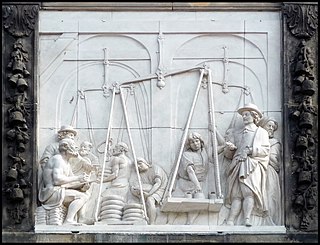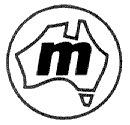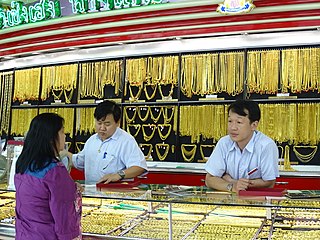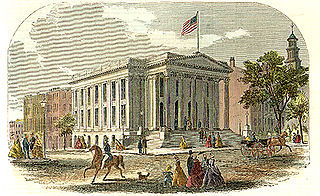Related Research Articles

The imperial system of units, imperial system or imperial units is the system of units first defined in the British Weights and Measures Act 1824 and continued to be developed through a series of Weights and Measures Acts and amendments.

Metrication or metrification is the act or process of converting to the metric system of measurement. All over the world, countries have transitioned from local and traditional units of measurement to the metric system. This process began in France during the 1790s, and has persistently advanced over two centuries, accumulating into 95% of the world officially only using the modern metric system. Nonetheless, this also highlights that certain countries and sectors are either still transitioning or have chosen not to fully adopt the metric system.

The pound or pound-mass is a unit of mass used in both the British imperial and United States customary systems of measurement. Various definitions have been used; the most common today is the international avoirdupois pound, which is legally defined as exactly 0.45359237 kilograms, and which is divided into 16 avoirdupois ounces. The international standard symbol for the avoirdupois pound is lb; an alternative symbol is lbm, #, and ℔ or ″̶.

United States customary units form a system of measurement units commonly used in the United States and most U.S. territories, since being standardized and adopted in 1832. The United States customary system developed from English units that were in use in the British Empire before the U.S. became an independent country. The United Kingdom's system of measures was overhauled in 1824 to create the imperial system, which was officially adopted in 1826, changing the definitions of some of its units. Consequently, while many U.S. units are essentially similar to their imperial counterparts, there are noticeable differences between the systems.

Tael, also known as the tahil and by other names, can refer to any one of several weight measures used in East Asia and Southeast Asia. It usually refers to the Chinese tael, a part of the Chinese system of weights and currency. The Chinese tael was standardized to 50 grams in 1959.

The baht is the official currency of Thailand. It can be divided into 100 satang. The issuance of currency is the responsibility of the Bank of Thailand. SWIFT ranked the Thai baht as the 10th-most-frequently used world payment currency as of December 2023.

The gram is a unit of mass in the International System of Units (SI) equal to one thousandth of a kilogram.
The ounce is any of several different units of mass, weight, or volume and is derived almost unchanged from the uncia, an Ancient Roman unit of measurement.

Metrication is the process of introducing the International System of Units, also known as SI units or the metric system, to replace a jurisdiction's traditional measuring units. U.S. customary units have been defined in terms of metric units since the 19th century, and the SI has been the "preferred system of weights and measures for United States trade and commerce" since 1975 according to United States law. However, conversion was not mandatory and many industries chose not to convert, and U.S. customary units remain in common use in many industries as well as in governmental use. There is government policy and metric (SI) program to implement and assist with metrication, however there is major social resistance for further metrication.
A system of units of measurement, also known as a system of units or system of measurement, is a collection of units of measurement and rules relating them to each other. Systems of measurement have historically been important, regulated and defined for the purposes of science and commerce. Instances in use include the International System of Units or SI, the British imperial system, and the United States customary system.

The Dutch units of measurement used today are those of the metric system. Before the 19th century, a wide variety of different weights and measures were used by the various Dutch towns and provinces. Despite the country's small size, there was a lack of uniformity. During the Dutch Golden Age, these weights and measures accompanied the Dutch to the farthest corners of their colonial empire, including South Africa, New Amsterdam and the Dutch East Indies. Units of weight included the pond, ons and last. There was also an apothecaries' system of weights. The mijl and roede were measurements of distance. Smaller distances were measured in units based on parts of the body – the el, the voet, the palm and the duim. Area was measured by the morgen, hont, roede and voet. Units of volume included the okshoofd, aam, anker, stoop, and mingel. At the start of the 19th century the Dutch adopted a unified metric system, but it was based on a modified version of the metric system, different from the system used today. In 1869, this was realigned with the international metric system. These old units of measurement have disappeared, but they remain a colourful legacy of the Netherlands' maritime and commercial importance and survive today in a number of Dutch sayings and expressions.

Metrication in Canada began in 1970 and ceased in 1985. While Canada has converted to the metric system for many purposes, there is still significant use of non-metric units and standards in many sectors of the Canadian economy and everyday life today. This is mainly due to historical ties with the United Kingdom, the traditional use of the imperial system of measurement in Canada, proximity to the United States, and strong public opposition to metrication during the transition period.

Metrication in Australia effectively began in 1966 with the conversion to decimal currency under the auspices of the Decimal Currency Board. The conversion of measurements—metrication—commenced subsequently in 1971, under the direction of the Metric Conversion Board and actively proceeded until the Board was disbanded in 1981.

Metrication, the process of introducing the metric system of measurement in place of imperial units, has made steady progress in the United Kingdom since the mid-20th century but today remains equivocal and varies by context. Most of government, industry, commerce, and scientific research use the metric system. Imperial units are officially used to specify journey distances, vehicle speeds and the sizes of returnable milk containers, beer and cider glasses, fresh milk is often still sold in multiples of pints, with the metric equivalent also marked, and precious metals are sold by the troy ounce. Metric units must be used when selling other packaged or loose goods, and imperial units can stand alongside the metric units, but it cannot stand out more than the metric units. Imperial units are also often used to describe body measurements and vehicle fuel economy. The national curriculum requires metric units and imperial units that still remain in common usage to be taught in state schools.

The earliest recorded systems of weights and measures originate in the 3rd or 4th millennium BC. Even the very earliest civilizations needed measurement for purposes of agriculture, construction and trade. Early standard units might only have applied to a single community or small region, with every area developing its own standards for lengths, areas, volumes and masses. Often such systems were closely tied to one field of use, so that volume measures used, for example, for dry grains were unrelated to those for liquids, with neither bearing any particular relationship to units of length used for measuring cloth or land. With development of manufacturing technologies, and the growing importance of trade between communities and ultimately across the Earth, standardized weights and measures became critical. Starting in the 18th century, modernized, simplified and uniform systems of weights and measures were developed, with the fundamental units defined by ever more precise methods in the science of metrology. The discovery and application of electricity was one factor motivating the development of standardized internationally applicable units.
Wa is a unit of length, equal to two metres or four sok (ศอก.) Wa as a verb means to outstretch (one's) arms to both sides, which relates to the fathom's distance between the fingertips of a man's outstretched arms. The 1833 Siamese-American Treaty of Amity and Commerce, reads, "[The] Siamese fathom...being computed to contain 78 English or American inches, corresponding to 96 Siamese inches." The length then would have been equivalent to a modern 1.981 metres. Since conversion to the metric system in 1923, the length as derived from the metre is precisely two metres, but the unit is neither part of nor recognized by the modern International metric system (SI).

The tical is a unit of mass historically used in Mainland Southeast Asia, particularly in the predecessor states of Myanmar, where it is known as the kyat (kyattha), and of Cambodia and Thailand, where it is known as the baht (bat). It formed the basis of the modern currencies the Myanmar kyat and the Thai baht, as well as the historical Cambodian tical, which were originally valued as the unit's weight of silver. It remains in widespread use in Myanmar, where it is approximately equivalent to 16.33 grams (0.576 oz), and in the gold trade in Thailand, where it is defined as 15.244 grams (0.5377 oz) for bullion and 15.16 grams (0.535 oz) for jewellery. For other uses, the baht is defined in Thailand as exactly 15 grams (0.5291 oz).

The hectare is a non-SI metric unit of area equal to a square with 100-metre sides (1 hm2), that is, 10,000 square meters, and is primarily used in the measurement of land. There are 100 hectares in one square kilometre. An acre is about 0.405 hectares and one hectare contains about 2.47 acres.

The Royal Thai Survey Department is a Special Services Group of Headquarters, Royal Thai Armed Forces (กองบัญชาการกองทัพไทย) tasked with conducting land and aerial survey, geodesy and geophysics works in Thailand. The headquarters of the Survey Department are located on Kanlayan Maitri Road in the Phra Borom Maha Ratchawang Subdistrict of Phra Nakhon District, Bangkok, and the current Department Director is Lieutenant General Noppadon Chotisiri.

The imperial and US customary measurement systems are both derived from an earlier English system of measurement which in turn can be traced back to Ancient Roman units of measurement, and Carolingian and Saxon units of measure.
References
- ↑ Minutes of the 7th General Conference on Weights and Measures, 1927, page 69
- 1 2 Giblin, R. W. (2008) [1908]. "Royal Survey Work.". In Wright, Arnold; Breakspear, Oliver T (eds.). Twentieth century impressions of Siam (65.3 MB). London&c: Lloyds Greater Britain Publishing Company. p. 126. Retrieved 28 January 2012.
All cadastral plans are plotted, drawn, and printed to a scale of 1 to 4,000....
- ↑ Great Britain. Foreign Office (1847). "1". Treaty of Commerce and Navigation with The United States. Vol. 22. London: James Ridgway and sons, Piccadilly. p. 592. Retrieved 26 January 2020.
...said fathom being computed to contain 78 English or American inches, corresponding to 96 Siamese inches....
{{cite book}}:|work=ignored (help) - 1 2 3 4 5 6 7 8 9 10 11 12 13 14 15 16 Royal Institute (2003), พจนานุกรม ฉบับราชบัณฑิตยสถาน พ.ศ. ๒๕๔๒ (Royal Institute Dictionary, BE 2542) (in Thai), Bangkok: Nanmee Books Publications, ISBN 974-9588-04-5, archived from the original on 2012-01-03.